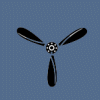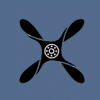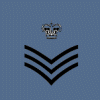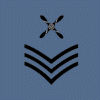The Royal Air Force 2300AD
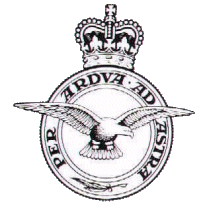
Overview
Introduction
The RAF is Britain's air force and the oldest such independent service. It is a force that has concentrated on its on Earth role in recent years but has rediscovered a colonial role in the Kafer War. It has its own unique organisation and systems of recruitment and training not to mention its rank structure. This article aims to illuminate some of these factors.
Acknowledgements
Thanks to David Gillon, Bryn Monnery and Peter Grining for feedback and ideas.
Narrative
The Lightning came off the runway as fast as it always did, tipping back and accelerating skywards, undercarriage clicking away into the airframe. It passed smoothly through the sound barrier and Flight Sergeant Davis made the aircraft curve round to the east as it made 10 000 meters. Seconds behind him, his wingman was following in his wake and they were over the North Sea inside 30 seconds.
'Magic One Zero this is Cobra Three on task,' Davis checked in with the duty AEW plane.
'Magic copy.' The Guardian was well aware of them but they always made the courtesy call. The FICOM data-feed was clear and un-interrupted through the AVIS-5.
'Hermes Four, this is Cobra Three on task.'
'Hermes copy.' Davis banked the fighter into the racetrack CAP that ran from the Humber to the Skaggerak.
Below them an Artemis MRS.2 from 42 Squadron had spotted a large German sub-fighter commerce raider in the area of Dogger Bank, breaking the Anglo-Scandinavian declared DMZ. 'Pinged' by the Artemis the German SU-Boat would be running fast and noisy for the SAM umbrella of Bremerhaven. The French would put up their ASW assets with a fighter escort to try and destroy one of the craft that had wrecked havoc on their shipping. The Germans too would scramble fighters to try and stop the French.
Davis and his wingman were on Quick Reaction Alert and first on the scene. Right now Fighter Command airfields across Britain were scrambling to get fighters in the sky. The RN carrier Invincible was already catapulting its ready aircraft and Scandinavian QRA planes were climbing up from Norway and Jutland.
The last time this had happened the French and Germans had made a mockery of the DMZ. That wasn't going to happen again, already ten planes were moving fast towards or around the Artemis and the supercavitating SU-Boat. Then the FICOM net began flashing, French planes were inbound and German airfields scrambling, things were about to turn hot.
Organisation
Recruitment
Service Terms
Culture
Rank Structure
Commands and Groups
Reserve Forces
Trades
Associated Forces
Major Facilities
Role Playing
The RAF comes under the control of the Ministry of Defence alongside its sister services. It is divided into two main elements, the regular RAF and the Royal Auxiliary Air Force, a voluntary reserve formation. The head of the RAF is the Chief of Air Staff who also sits on the Defence Staff at Whitehall.
The RAF is operationally divided into a series of Commands, each of which has a specific function. Fighter Command is responsible for the protection of the airspace of the British Isles, Bomber Command for strategic force projection and Strike Command for tactical force projection. Coastal Command provides land based air support for the Royal Navy and also had joint responsible for Search and Rescue around the UK coast. Transport command includes heavy airlift and tanker support. Training Command is responsible for all flight training and includes some miscellaneous functions. Orbital Command includes the RAF's vestigial interface capability and ground based ASAT units. Lastly the Defence Command includes RAF Regiment and RAuxAF Regiment units for the defence of RAF facilities.
The RAF also has a number of Groups, which can be independent or part of Commands. These are generally for administrative rather than operational purposes except for the independent Groups. These are usually stationed in places away from the areas under the control of the Commands. However their combat power is usually provided by elements seconded from the Commands. The most notable of these are No.4 Group, deployed in the South Atlantic, or No.35 Group deployed on Tirane. Whilst in the past the RAF has had a large presence in the colonies it has since largely handed over to locally raised airforces to concentrate on its role on Earth. There are also operational, expeditionary Groups formed with RAF and RN resources known as Joint Tactical Air Groups which are formed in response to operational needs.
The next level of in the chain of command is the Wing. The Wing is a tactical HQ formation and are highly flexible in the assets they can control. Each command has a number of Wings which can have any combination of aircraft under its command and are tailored to provide a specific force package. The Wing Commander and his staff are responsible for planning and commanding operations if control at the Command level is not warranted. The Wing Commander may accompany missions in the air or command from the ground depending on the circumstances.
The basic building block of the RAF is the Squadron. This is a grouping of between 6 and 18 aircraft together with air and ground crews, normally comprising around 200 personnel, although Bomber and Coastal Command units can be larger. It is at the squadron level most RAF unit cohesion and identification is generated. Unlike the army, RAF personnel expect to be moved between a number of squadrons during their careers although they will generally expect to work with one aircraft type or within the same command.
Like the other services the RAF has three main recruitment channels. Direct from schools and other educational establishments which receive frequent visits from recruiting teams. Through the Recruitment Offices present in every major town. Lastly the RAF has a substantial advertising budget and makes the most of its highly visual aircraft it campaigns. The RAF has relatively little difficulty obtaining sufficient recruits for itself and is regarded as being very media savvy. It should be noted that the RAF accepts only graduates of tertiary level education as a minimal qualifications, even for the RAF Regiment
All recruits will undergo a battery of testing, during initial interviews and screening a three day residential Familiarisation at RAF Cranwell. These tests include medical examination as well as aptitude testing which will determine career choices for the successful applicant. In particular in the Pilot, Remote System Operator and Air Traffic and Fighter Controller specialities use these tests to screen for further testing. This universal testing has led to a rigidly meritocratic outlook in these key specialities as some perhaps surprising candidates can find themselves in a much more highly powered role than they expected.
Those successful candidates
applying for ground careers will then be allocated a training place.
Those applying for officer positions in the ground trades will then
have to undergo Officer Selection also at RAF Cranwell. For potential
flight crew and controllers there remains another battery of testing
to undergo to winnow out the best qualified candidates for the RAF's
available positions. Those surplus to requirement but with sufficient
skills may be referred onto the other services; the Army Air Corps in
particular picks up many excellent potential tilt-rotor pilots through
this root as the RAF only has a limited number of tilt-rotor squadrons.
The RAF has a system in place to identify and recruit potential members as they attend a tertiary education establishment. Most of these are encouraged to attend nearby RAuxAF units but potential aircrew can, after passing the usual tests, be taught to fly during their studies. After graduation these individuals still have to complete Phase 1 training but will skip basic flight training.
Overseas recruitment
Like the British Army the RAF is allowed to recruit from overseas, including citizens of any country of the Commonwealth. The RAF attracts pilots especially from the British Commonwealth as well as from certain parts of the Commonwealth of Nations. Many of these have already served in their own national air forces and these are especially welcomed into the RAF. There are many RAF flight crew who wear the flashes of Wellon, Australia, New Zealand and Canada.
Secondment
The RAF has in place a system of bilateral secondment to other nations. This is mainly confined to pilots, although the RAF Regiment also conducts exchanges. The RAF finds this an excellent way of keeping up with evolving doctrine and tapping combat experience. Indeed seconded RAF pilots flew on both sides during the War of German Reunification, something that caused much embarrassment when revealed in the press. A significant number of pilots flew with the Armée de l'Air in the Central Asian War and several were lost.
Training in the RAF follows the familiar British pattern of the Training Phases. Phase 1 Training is consolidated at RAF Honington in Suffolk and consists of six weeks of training undertaken by every single recruit to the RAF. This training covers the basics every airman has to know and is just enough to turn a civilian into a serviceman. Whilst other services are scathing about RAF Phase 1 Training it is tailored to what the RAF requires and turns out an airman able to march, have some idea of firearms and so forth. One element of training the RAF does take very seriously is NBC defence.
RAF Phase 2 is training specific to trade. Aircrew begin their flying training, RAF Regiment gunners begin infantry training and so on. For those recruits being commissioned into a ground crew branch it is during Phase 2 they are sent to RAF Cranwell for officer training. The length of Phase 2 training varies hugely depending on the trade group being pursued, from a few months to years. At the end of Phase 2 training the airman is deemed competent to be sent to an operational unit.
Phase 3 training is continuation training undertaken with the operational unit, although some courses may be run by outside agencies.
To take pilot training as an example. The potential pilot, screened by the recruiting process, will initially do their Phase 1 at RAF Honington alongside every other recruit. They will then be posted, as probationary Flight Sergeants, to either No.1 or No.2 Flight Training School for basic flight training, a high intensity course of ten weeks duration. They will then be posted to either 3 or 4 FTS depending on the stream the pilot is moving into. This more advanced training will last six months, remaining at a high pace. Finally the pilot will be despatched to one of the Operational Conversion Units to train on the specific aircraft he will fly which will usually take around three months. After successfully passing through the OCU he will be finally posted to an operational squadron.
The RAF make intensive use of a range of simulators throughout their training process for both air and ground crew. This enables training to be delivered cheaply and safely whilst maximising useful training time on real aircraft. It is this equipment, accompanying training methods and pre-screening that allows the RAF to train personnel so quickly, indeed the RAF can train a fast jet pilot in around twice the time the army can train an infantryman.
Standard contract lengths in the RAF are three years for ground crew and five years for aircrew. These can be extended at several points in the career and the maximum length of service is 32 years. Length of service is primarily dependent on the ability of the airman to do their particular jobs. Like the RN and British Army, RAF personnel due to serve off-world must have at least 3 years remaining on their contracts.
Those wishing to leave the RAF can do so at certain points in their career, usually once every two or three years. If they want to leave at other times they must have a good reason or buy themselves out of the RAF, at a cost of roughly 6 months wages. Certain trade groups must also serve a reserve commitment with the RAuxAF, usually for three years but this can be extended if the individual wishes. These groups include aircrew, fighter controllers and intelligence as well as several others.
Retention is good within the RAF and promotion is based on length of service in most trade groups. The aircrew retention is good as there are relatively few places open in the heavily regulated civilian airline industries in the core.
The culture of the RAF is distinctly different of that of any other British service notwithstanding its ancient roots in the Army's RFC and Royal Naval Air Service. Throughout its history the RAF has striven to try and wage war independently of the other arms of the military. The RAF is very much a believer in the primacy of air power and works towards a purely air dominated doctrine. Consequently co-operation with other services can sometimes be a matter of lip service. Elements of the RAF that do work with Army and RN units such as Strike and Coastal Commands can find themselves at the back of the procurement queue when compared to Fighter and Bomber Commands.
The fighting against the Kafers on the French Arm has changed this situation somewhat. The success of the RAF-RN Joint Tactical Air Groups in combination with ground forces has increased the profile of Strike Command massively. The RAF has been quick to make the best media capital out of this and recruitment has been massively oversubscribed.
Due to its technical nature the RAF works primarily from fixed air bases with excellent facilities. This has given rise to the perception in the other services that the RAF is a '9 to 5' organisation with a taste for soft living. However this is not held out by reality; both Fighter Command and Bomber Command have units continuously on high readiness whilst Strike Command spends much of its exercise time deployed forward into the field. The tough RAF Regiment would also dispute the 'softy' tag.
The RAF is very much a meritocratic service thanks to its system of anonymous screening and rigorous training. There is no such thing as the 'old school tie' in the service. However divisions are prominent between senior officers who have come up through the different Commands. It is rare indeed for a Transport Command officer to hold high office, positions that are dominated by those with a Fighter or Bomber Command background.
The RAF retains the rank structure it adopted when it was separated from the Army. There are no alternative ranks within the RAF, even the ground military orientated RAF Regiment uses this system. The standard starting rank for all flight crew is Flight Sergeant.
Enlisted ranks
|
Rank |
Typical Position |
Equivalent British Army Rank |
|
|
Aircraftman/ Aircraftwoman |
Junior ground crew |
Private |
 |
|
Leading Aircraftman |
Junior ground crew |
Private (senior) |
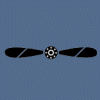 |
|
Senior Aircraftman/ Junior Technician |
Junior ground crew |
Lance Corporal |
|
|
Corporal |
Junior ground crew |
Corporal |
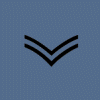 |
|
Sergeant |
Senior ground crew/ Junior air crew (non pilot) |
Sergeant |
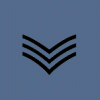 |
|
Flight Sergeant/ Chief Technician |
Senior ground crew/ Junior air crew |
Colour Sergeant |
|
|
Warrant Officer/ |
Senior NCO/ Senior air crew |
WO2 |
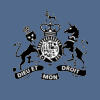 |
Commissioned ranks
|
Rank |
Typical Position |
Equivalent British Army Rank |
|
|
Pilot Officer |
Newly commissioned officer |
Second Lieutenant |
 |
|
Flying Officer |
Newly commissioned officer/ Squadron staff |
Lieutenant |
 |
|
Flight Lieutenant |
Flight commander |
Captain |
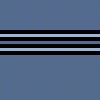 |
|
Squadron Leader |
Squadron commander/ Wing staff |
Major |
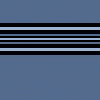 |
|
Wing Commander |
Wing commander/ Group/Command staff |
Lieutenant Colonel |
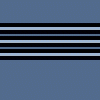 |
|
Group Captain |
Group commander |
Colonel |
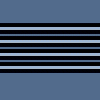 |
|
Air Commodore |
Command/RAF Staff |
Brigadier |
 |
|
Air Vice-Marshal |
Command commander |
Major General |
 |
|
Air Marshal |
Senior staff officer |
Lieutenant General |
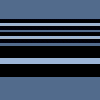 |
|
Air Chief Marshal |
Chief of Air Staff |
General |
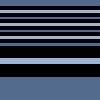 |
|
Marshal of the RAF |
Chief of the Defence Staff. Rank only held if this position is filled by RAF officer. |
Field Marshal |
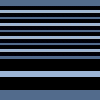 |
The RAF has an array of different Commands and independent Groups.
Fighter Command
Fighter Command is responsible for the air component of the defence of the of the United Kingdom. Considering a modern threat can arise at virtually any time Fighter Command is maintained at high levels of readiness with QRA aircraft armed, fuelled and with pilots in the cockpit at all times. The Command utilises an array of manned and unmanned fighter aircraft, missile and laser defence systems all guided by airborne and ground control and surveillance facilities. Fighter Command is a flexible system and can incorporate RN Carrier Air Wings and allied aircraft when required. It also controls the RAF's airborne ASAT capabilities.
Strike Command
Strike Command has the task of the projection of tactical air power, usually in conjunction with the Army and Royal Navy. The Command is trained to deploy forwards from its UK bases and operate in expeditionary mode either from rough strips or RN Carriers. It is primarily equipped with manned fighter aircraft and has its own airborne command and surveillance assets. It can strike with equal capability at air, sea or ground targets. Strike Command has a large number of aircraft on deployment either on Earth, Tirane or with JTAGs in the colonies where they have seen action against the Kafers.
Bomber Command
This Command is seen by some as Britain's 'big stick', although the RN may disagree. It is tasked with providing strategic power projection and reconnaissance anywhere on Earth. It is equipped with long range, high capability aircraft with substantial drone, conventional and nuclear armaments. It also has specialised reconnaissance aircraft which supplement Britain's satellite systems.
Coastal Command
Coastal Command has the role of providing ground based air support to the Royal Navy and aiding the defence of Britain's waters. This is provided by its squadrons of highly capable ASW and ASuW aircraft which can range the oceans of the world and work in close concert with the RN. Coastal Command also has part of the responsibility for providing Search and Rescue around the coast of the British Isles. It also has the responsibility for the RAF's CSAR capability.
Transport Command
This Command is responsible for a variety of tasks. The main one of these is the provision of heavy tactical and strategic fixed wing airlift for British forces. The second is the provision of air-to-air refuelling to any other Command that requires its services and operates both manned and unmanned tankers. Lastly the Command provides VIP air transport for British royalty, politicians and senior commanders.
Training Command
Training Command is a widespread and busy organisation. It is responsible for all training, both on the ground and in the air, of the RAF. One of its major responsibilities is flying training which takes airmen from the very basics up to flying the most sophisticated aircraft. Training Command also has a remit for overseeing operational conversion and for tactical training. Lastly it looks after smaller responsibilities like light aircraft used for recruiting purposes, test pilots and the RAF Historical Squadron.
Orbital Command
Orbital Command has responsibility for ground based fixed and mobile ASAT resources manned by the RAF Regiment. It also has a small number of landers for interface duties. Orbital Command is mostly a rump force as the bulk of its duties were taken over by the Royal Space Corps on its formation.
Defence Command
Defence Command is responsible for the tactical protection of the RAF and is manned by units of the RAF Regiment and the RAuxAF Regiment. The command has forces for ground protection and SAM units for air protection, it also provides personnel for mountain rescue and CSAR. It has a total of the equivalent of nine battalions and is spread across Britain and has detachments on duty in the colonies.
No.4 Group
4 Group is the key RAF force deployed to the South Atlantic as part of the long Cold War with Argentina. Its main responsibilities are in the air defence of the Falkland Islands and the provision of air support to British forces in Antarctica. The Group does not include elements like air-to-air tankers and maritime aircraft which remain under command of their respective Commands. The Group works hand in hand with the Carrier Air Wings of the RN's Atlantic Fleet.
No.22 Group
The RAF withdrew its major assets from New Africa in 2285 and handed over its responsibilities to the newly formed Royal New Africa Air Force. 22 Group was the RAF's vestigial presence and fulfilled purely administrative and liaison tasks. That changed with the Kafer War and the arrival of JTAG-2 to support ground forces, however that body usually bypassed 22 Group which became an irrelevance. Staff from the Group instead bolstered the RNAAF and other HQs whilst some with aircrew qualifications were moved to flying operations with JTAG-2 or RNAAF.
Today the Group has been reconstituted as a Commonwealth body and oversees British, New African and Commonwealth air power on the continent. There has been some discussion about expanding the Group to Command status, if only to give the airmen more clout.
No.23 Group
23 Group is based in Alicia and has long been seen as one of the RAF's sinecure posts. The Treaty of Heorot with France reduced the numbers of British regulars on-world and the ADF expanded to fill the gap. As a result the RAF has traditionally had no assets permanently deployed here and the Group was responsible for liaison with the Air Wing as well as monitoring seconded RAF pilots. The Kafer War has changed the situation somewhat and two JTAGs were based here before the Battle of Beowulf and the ADF/AW swelled dramatically. Now the Group has returned to its tasks of liaison, especially due to the large numbers of seconded RAF personnel in the ADF/AW.
No.24 Group
This Group based on Crater is the ultimate sinecure position as neither the RAF or the CDF has any significant air capability. The Group was an irrelevance, and indeed on one occasion an inconvenience, during the Kafer occupation of Crater. The Group has been reformed but any airlift remains in the hands of the CDF ground force and RSN.
No.25 Group
The small, relatively young colony of New Cornwall has only a vestigial indigenous defence capability and relies on British forces for its defence. 20 Group before the war was responsible for a small force mainly tasked with maritime surveillance of Elysia whilst a small force of tactical aircraft was present for the defence of the colony and to operate with the British Army garrison. Part of this force was sent to New Africa during the war and when the invasion of New Cornwall came the cupboard was mostly bare. However the group responded with alacrity utilising civil aviation to shuttle troops to areas under attack and deployed its limited assets with imagination. The Group has received a small reinforcement since the war.
No.35 Group
35 Group based in Wellon on Tirane is the most important of the off-World RAF Groups. The RAF conducts frequent tactical training and testing here and also has squadrons deployed to support the British 4th Armoured Division. Links with the Royal Wellon Aerospace Force are extremely close.
The RAF's reservists all come under the auspices of the Royal Auxiliary Air Force (RAuxAF). This is a body that contains both regular and volunteer reservists. The RAuxAF is employed predominantly in ground roles in the UK, most personnel are dedicated to units with Fighter, Bomber, Coastal or Transport Command. The RAuxAF Regiment is a major component of Defence Command and has stepped up its commitments following the deployment of regular RAF Regt units to the French Arm. Lastly the RAuxAF also contains recently released reservist pilots who are kept up to date with regular training with their respective OCU but can be sent to an operational squadron if required. A large number of RAuxAF pilots have been called up to replace regular pilots on secondment with the RNAAF and ADW/AW.
Every airman and officer in the RAF is a member of a trade group. These are all combined together in the Squadrons, Wings, Groups and Commands.
Aircrew - Pilot
The cutting edge of the RAF are the pilots that fly its warplanes, they are at the apex of the RAF and are supported by the rest of the structure. Needless to say the pilot retains much of the glamour that has accompanied the profession since the Wright Brothers. RAF pilots are usually streamed into a specific aircraft type, although they may transfer to a similar one during their careers.
Aircrew - Weapon Systems Operator
The WSO is usually included in the crew of larger aircraft such as those found in Bomber or Coastal Command. They have the responsibility for 'fighting' the aircraft and the operation of its weapon systems including EW systems.
Remote Systems Operator
RSOs are known as 'geeks' in RAF slang. They are responsible for the operation of the RAF's drone aircraft which range from the large Victor tankers to the insanely quick Gladiator point defence fighter. There is a great rivalry between pilots and RSOs, partly because they have such different approaches. RSOs usually work from fixed or mobile facilities on the ground but some are also included in Bomber and Coastal Command aircrews.
Fighter Controller
The Fighter Controllers are the rarest breed within the RAF. They are pure tacticians responsible for the tactical control of air battle providing support to the pilots in the air. Their job involves being able to hold a fast moving 3 dimensional battle picture in the heads with the aid of audio visual aids. Some nations use computers alone for this job but the RAF still relies on an element of human intuition. Fighter Controllers are assigned to Wing HQs in Fighter, Strike and Bomber Command as well as aircrew in 2 and 13 Groups.
Air Traffic Controllers
Air Traffic Controllers are responsible for the smooth operation of RAF flight operations on airfields and the integration of RAF flying with civilian aviation. Given the highly crowded nature of the skies of Earth this is no small responsibility.
Ground Crew - Avionics
Avionics air crew are responsible for the maintenance of all the electronics, sensors and computers inside the aircraft. Even with modern self-diagnostics and simple line replacement units failures of such systems can easily prove catastrophic.
Ground Crew - Aero Engineering
This trade is dedicated to maintaining all the mechanical systems of the aircraft including airframe and engines.
Ground Crew - Armourer
Armourers are responsible for the maintenance and correct loading of weapon systems onto the airframe. Most modern weapons are highly sophisticated and the armourer must check both functionality and that weapons are in the correct operating modes.
General Engineering
General engineers are responsible for maintaining the equipment and facilities on RAF bases, they have no responsibility for aircraft.
Intelligence
The Intelligence branch are tasked with providing intelligence and information for the planning of operations, such as details on enemy equipment and capabilities. They also process the data gathered by all RAF aircraft, but especially that gained by dedicated recce aircraft.
Communications
The comms branch is dedicated to maintaining the communications capability of the RAF. This includes standard ground links as well as broadcast links such as the FICOM net, they also have the capability to put into place links from tactical locations in support of Strike Command operations. The comms branch is also responsible for defensive information warfare operations.
General Duties
The GD branch provides all administrative support necessary for the conduct of RAF operations. This runs from secretarial and financial, to motor transport and catering, to physical training instructors and musicians. The GD branch has none of the glamour associated with fighter pilots but without them little would be achieved.
Medical
The medical branch naturally looks after all of the medical requirements, both operational and routine, of the RAF.
Security
This branch includes both the RAF Police and the RAF Fire and Rescue service.
RAF Regiment
The RAF Regt is responsible for the military security of the RAF and includes field and short range air defence unit. More specialist elements are responsible for ceremonial, mountain rescue, search and rescue and counter-infiltration duties.
Logistics and Movement
L&M are responsible for the supply of all RAF units and the co-ordination of RAF airlift. L&M provides support for the whole RAF although Movements Control are concentrated with Transport Command.
The RAF has traditionally concentrated most of its air power on Earth with only a limited colonial role. However it has been proactive in establishing colonial air forces to undertake the roles it takes on Earth. Most of these were formed in the image of the RAF, using similar structures and usually RAF personnel. The widespread use of secondment has made sure these links are maintained.
The Royal Wellon Aerospace Force is the strongest of the these forces and bilateral links are strong. The RAF is a partner in the Joint Air Warfare Centre near New Capetown, which is a centre of excellence for air warfare and the development of doctrine and equipment. The Alicia Defence Force Air Wing is another powerful force although its links with the RAF are not so strong. The Royal New Africa Air Force is a young air force which is very much reliant on RAF support, especially since the Kafer War.
RAF bases come under the command of a Station Commander, who can be drawn from almost any trade group and will carry the rank of Wing Commander or Group Captain depending on the size of the base. The Station Commander is responsible for the operation, administration and defence of the base but is not in the command chain of the Squadrons or Wings flying from the base.
RAF Brize Norton
Brize Norton in Oxfordshire is the centre of the Transport Commands personnel movement and air-to-air refuelling. When deploying from the UK almost all troops will move through Brize and it is an extremely busy place.
RAF Cranwell
Cranwell in the Midlands is home to most of the RAF's recruitment, screening and selection procedures and all potential RAF recruits pass through its doors. It also hosts the RAF's officer training college as well as a range of other establishments. There are a large number of training aircraft here belonging to 1 FTS which provides basic training for RAF and RN pilots.
RAF Kinloss
Kinloss is another of the RAF's key bases in Scotland, this one dedicated to Coastal Command's Artemis aircraft that scour the seas around the UK.
RAF Leeming
Leeming is a Fighter Command base in North Yorkshire and operates over 30 Lightning interceptors. The airfield is well equipped with a multitude of runways, taxiways and armoured hanger complexes. Stretches of a nearby motorway have been altered to allow them to operate as emergency runways in time of war.
RAF Lossiemouth
Lossiemouth is Bomber Command's northern outpost and is home to three squadrons of powerful Vanguard bombers. The base has been expanded significantly and one squadron always has some of its bombers on quick reaction alert.
RAF Lyneham
Lyneham is home to the RAF's tactical airlift capability. It hosts the Atlas and Constellation aircraft of Transport Command and alongside Brize Norton is one of the busiest military airports in the UK.
RAF Scampton
RAF Scampton in remote East Anglia is the home of the crack 8 Group and their MAe Mosquito long range strike and recce aircraft.
RAF Waddington
Waddington is one of the most secure bases in the country. It is home to most of the Guardian AEW aircraft as well as strategic recce aircraft of Bomber Command. The base has an impressive complex of armoured hangers, dispersals and widened taxiways.
RAF Wittering
Wittering is home to Strike Command Tempest ground attack fleet, although much of it is currently deployed elsewhere. Wittering has a long association with RAF tactical interdiction aircraft from the legendary Harrier through to the recently retired Hunter. Wittering is a base that is somewhat in need of updating.
RAF Mount Pleasant
This is the RAF's main base in the South Atlantic and is located on East Falkland. It is home to 4 Group as well as detachments from Coastal and Transport Command. Mount Pleasant is well defended, heavily fortified and kept a high states of readiness as a result of the Cold War with Argentina.
Background Skills
All characters must join the RAF at the age of 21 or older. Those born on Earth and joining at 21 can spend 3 extra background points on normal Core Skills.
Aircrew - Pilot
Initial Skills: Combat Rifleman - 1, Sidearm - 1, Aircraft pilot - 4, Mechanical - 1, Electrical - 1, Survival - 1, Swim - 1 (if not a background skill)
Primary Skills: Heavy
Weapons, Leader, Tactics, Aircraft Pilot, General Skills (except Prospecting).
Related Skills: Combat Skills, Ground Vehicle, Hover Vehicle,
Computer, Bureaucracy.
Aircrew - Weapon Systems Operator
Initial Skills: Combat Rifleman - 1, Sidearm - 1, Heavy Weapons - 4, Mechanical - 1, Electrical - 1, Survival - 1, Swim - 1 (if not a background skill)
Primary Skills: Heavy
Weapons, Leader, Tactics, General Skills (except Prospecting).
Related Skills: Combat Skills, Ground Vehicle, Hover Vehicle,
Computer, Bureaucracy.
Remote Systems Operator
Initial Skills: Combat Rifleman - 1, Sidearm - 1, Aircraft pilot (Remote) - 4, Mechanical - 1, Electrical - 1
Primary Skills: Heavy
Weapons, Leader, Tactics, Aircraft Pilot, General Skills (except Prospecting).
Related Skills: Combat Skills, Ground Vehicle, Hover Vehicle,
Computer, Bureaucracy.
Fighter Controller
Initial Skills: Combat Rifleman - 1, Sidearm - 1, Tactics - 4, Computer - 2
Primary Skills: Tactics,
General Skills (except Prospecting).
Related Skills: Combat Skills, Ground Vehicle, Hover Vehicle,
Computer, Bureaucracy.
Air Traffic Controllers
Initial Skills: Combat Rifleman - 1, Sidearm - 1, Computer - 3, Bureaucracy - 2
Primary Skills: Computer,
Bureaucracy, General Skills (except Prospecting).
Related Skills: Combat Skills, Ground Vehicle, Hover Vehicle,
Computer, Bureaucracy
Ground Crew - Avionics
Initial Skills: Combat
Rifleman - 1, Sidearm - 1, Electrical - 4. Mechanical - 1, Computer
- 2, Hover Vehicle - 1, Ground Vehicle - 1, First Aid - 1
Primary Skills: Computer, Ground Vehicle, Hover Vehicle, General
Skills (except Prospecting).
Related Skills: Combat Skills, Bureaucracy
Ground Crew - Aero Engineering
Initial Skills: Combat
Rifleman - 1, Sidearm - 1, Electrical - 1. Mechanical - 4, Computer
- 2, Hover Vehicle - 1, Ground Vehicle - 1, First Aid - 1
Primary Skills: Computer, Ground Vehicle, Hover Vehicle, General
Skills (except Prospecting).
Related Skills: Combat Skills, Bureaucracy
Ground Crew - Armourer
Initial Skills: Combat
Rifleman - 1, Sidearm - 1, Electrical - 2. Mechanical - 2, Computer
- 2, Hover Vehicle - 1, Ground Vehicle - 1, First Aid - 1
Primary Skills: Computer, Ground Vehicle, Hover Vehicle, General
Skills (except Prospecting).
Related Skills: Combat Skills, Bureaucracy
General Engineering
Initial Skills: Combat
Rifleman - 1, Sidearm - 1, Electrical -3, Mechanical - 3, Hover Vehicle
- 1, Ground Vehicle - 1, First Aid - 1
Primary Skills: Computer, Ground Vehicle, Hover Vehicle, General
Skills (except Prospecting).
Related Skills: Combat Skills, Bureaucracy
Intelligence
Initial Skills: Combat
Rifleman - 1, Sidearm - 1, Information Gathering - 3, Computer - 1,
Bureaucracy - 1
Primary Skills: Computer,
Bureaucracy, General Skills (except Prospecting).
Related Skills: Combat Skills, Ground Vehicle, Hover Vehicle,
Computer, Bureaucracy.
Communications
Initial Skills: Combat Rifleman - 1, Sidearm - 1, Computer - 3, Bureaucracy - 1
Primary Skills: Computer,
Bureaucracy, General Skills (except Prospecting).
Related Skills: Combat Skills, Ground Vehicle, Hover Vehicle,
Computer, Bureaucracy.
General Duties
Initial Skills: Combat
Rifleman - 1, Sidearm - 1, Computer - 2, Bureaucracy - 2, Ground Vehicle
- 1, Hover Vehicle - 1, First Aid - 1
Primary Skills: Computer,
Bureaucracy, General Skills (except Prospecting).
Related Skills: Combat Skills, Ground Vehicle, Hover Vehicle,
Computer, Bureaucracy.
Medical
Initial Skills: Combat
Rifleman - 1, Sidearm - 1, Ground Vehicle - 1, Hover Vehicle - 1, First
Aid - 4 and Bureaucracy - 2.
Primary Skills: Combat Rifleman, Sidearm, Medical, Ground Vehicle,
Hover Vehicle, General Skills (except Prospecting).
Related Skills: Combat Skills, Intellectual Skills.
Security
Initial Skills: Combat
Rifleman - 2, Sidearm - 1, Melee - 3, Ground Vehicle - 2, Hover Vehicle
- 1, Bureaucracy - 1, Information Gathering - 1, First Aid - 1. (Swim
- 1 if not chosen as Background Skill)
Primary Skills: Combat Rifleman,
Sidearm, Intellectual Skills, Ground vehicle, Hover Vehicle, General
Skills (except Prospecting).
Related Skills: Combat Skills.
RAF Regiment
Initial Skills: Combat
Rifleman - 4, Heavy Weapons - 2, Melee - 2, Hover Vehicle - 1, Stealth
- 1, Tactics - 1 and First Aid-1 (Ground Vehicle - 1, Swim - 1 if not
chosen as Background Skills)
Primary Skills: Combat Skills, Ground Vehicle, Hover Vehicle,
Stealth, General Skills (except Prospecting).
Related Skills: Bureaucracy.
Logistics and Movement
Initial Skills: Combat
Rifleman - 1, Sidearm - 1, Ground Vehicle - 3, Hover Vehicle - 3, First
Aid - 1, Bureaucracy - 1, Electronics - 1 and Mechanical - 1. (Swim
- 1 if not chosen as Background Skill)
Primary Skills: Combat Rifleman, Sidearm, Bureaucracy, Ground
vehicle, Hover Vehicle, General Skills (except Prospecting).
Related Skills: Combat Skills, Intellectual Skills.
Copyright 2009, D Hebditch


